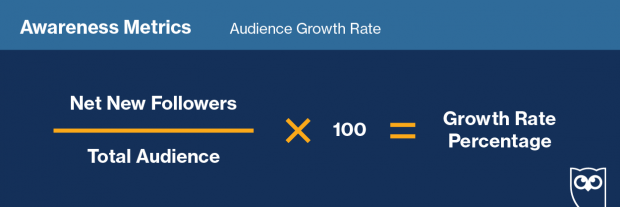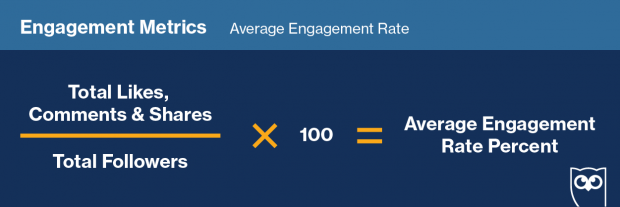What are social media metrics? And why are they important to track?
As a social media professional, they’re your chance to demonstrate the value of your work, and the impact of the decisions you’ve made.
If your boss asks you to talk data, take the opportunity to be a pro and go beyond the surface-level, “vanity” metrics—the likes and shares and retweets. Instead, focus on the data that matters—the numbers that prove your effort has had a positive, bottom-line impact on the business.
The right data will assure executives that their investment in social is paying off. It’ll also help you continue to make smarter, more data-driven decisions moving forward.
This article identifies the social media metrics that really matter, why they’re important, and how to track them.
Ready to make an impression?
Table of contents
The social funnel: a breakdown
Awareness metrics
Engagement metrics
Conversion metrics
Customer metrics
The most important social media metrics for marketers
The social funnel: a breakdown
Before diving into social media metrics, let’s review where each one lives in the social funnel.
For the purposes of this article, we’ll segment the funnel into four key customer journey stages:
- Awareness: these metrics illuminate your current and potential audience.
- Engagement: these metrics show how audiences are interacting with your content.
- Conversion: these metrics demonstrate the effectiveness of your social engagement.
- Consumer: these metrics reflect how active customers think and feel about your brand.
Every stage is populated with its own set of must-measure metrics, KPIs that shed light on the effectiveness of your social media marketing.
Let’s dive in.
Awareness metrics
These numbers illuminate your current and potential audience.
1. Brand Awareness
Brand Awareness is the attention your brand gets—across all social media—during a reporting period, or a specific span of time that yields statistically relevant data.
Attention can be expressed through a variety of social media metrics, including @mentions, shares, links, and impressions. Reporting periods are also variable, usually lasting a week, a month, or a quarter.
How to track it:
STEP 1: Determine the attention metric(s) your organization wants tied to brand awareness.
STEP 2: Determine the reporting period your organization wants tied to brand awareness.
STEP 3: Be consistent. Consistency ensures that you’re benchmarking trends with accurate, dependable data.
Note: A brand monitoring tool makes it easier to track every time someone mentions you on social media, with or without an @mention.
2. Audience Growth Rate
Audience Growth Rate measures the speed at which your brand’s following increases on social media. It’s how quickly you gain followers.
As access to the internet continues to increase around the world, brands’ social media followings will also increase.
But the question you should be asking is not, “How many net new followers did we get last month?” Instead, ask, “How fast did we gain last month’s net new followers—and was it faster than our competition?”
How to track it:
STEP 1: Measure your net new followers (on each platform) over a reporting period.
STEP 2: Divide your net new followers by your total audience (on each platform) and multiply by 100 to get your audience growth rate percentage.

Note: You can track your competitors’ progress the same way.
3. Post Reach
Post Reach denotes how many people have seen a post since it went live.
This metric is easy to find and even easier to understand. Most importantly, it’s actionable, since it’s affected by the timing (i.e., when is your audience online?) and the content (i.e., what does your audience find valuable?) of your post.
How to track it:
STEP 1: Measure the reach of any given post.
STEP 2: Divide the reach by your total number of followers and multiply by 100 to get your post reach percentage.

Note: On Facebook, the “When Your Fans Are Online” feature will tell you the optimal time to post. Use this data to increase your reach.

4. Potential Reach
Potential Reach measures the number of people who could, realistically, see a post during a reporting period.
In other words, if one of your followers shared your post with her network, approximately 2% to 5% of her followers would factor into the post’s potential reach.
Understanding this metric is important because, as a social marketer, you should always be working to expand your audience. Knowing your potential reach enables you to gauge your progress.
How to track it:
STEP 1: Use a brand monitoring tool to track your total number of brand mentions.
STEP 2: Record how many followers saw each mention (i.e., the audience of the account that mentioned you).
STEP 3: Multiply those two numbers together to get your Theoretical Reach, or the absolute maximum number of people who could, in theory, see your brand mentions.
Your potential reach is 2% to 5% of your theoretical reach.

5. Social Share of Voice (SSoV)
Social Share of Voice measures how many people are mentioning your brand on social media compared to your competitors.
Mentions can be either:
- Direct (e.g., “@Hootsuite”)
- Indirect (e.g., “hootsuite”)
SSoV is, essentially, competitive analysis: how visible—and, therefore, relevant—is your brand in the market?
How to track it:
STEP 1: Measure every mention your brand receives—direct and indirect—across your social networks.
STEP 2: Measure your competitors’ mentions during the same reporting period.
STEP 3: Add your mentions and those of your competitors to get the total industry mentions.
STEP 4: Divide your brand mentions by the grand total and multiply by 100 to get your SSoV percentage.

Note: Using social media analytics tools will make this process easier.
Engagement metrics
These numbers show how people are interacting with your content.
6. Applause Rate
Applause Rate is the number of approval actions (e.g., likes, favorites) a post receives relative to your total number of followers.
When a follower likes or favorites one of your posts, she’s acknowledging that it’s valuable to her. Knowing what percentage of your audience finds value in the things you post can—and should—inform your content moving forward.
How to track it:
STEP 1: Add up the total approval actions a post received over the course of a reporting period.
STEP 2: Divide that number by your total followers and multiply by 100 to get your applause rate percentage.

Note: Use a social media impact tool to help track approval actions and simplify the process.
7. Average Engagement Rate
Average Engagement Rate is the number of engagement actions (e.g., likes, shares, comments) a post receives relative to your total number of followers.
It’s an important metric because higher engagement means your content is resonating with the audience. To prove that, track the engagement rate of every post. If you have a high engagement rate, the actual number of likes and shares and comments is irrelevant.
How to track it:
STEP 1: Add up a post’s total likes, comments, and shares.
STEP 2: Divide by your total number of followers and multiply by 100 to get your average engagement rate percentage.

Note: The benchmark for this metric is different on every platform.
Facebook and Twitter, for example, typically have lower engagement rates (e.g., 0.5% to 1%). Instagram, on the other hand, is known for its relatively high engagement rates (e.g., 3% to 6%).
Bonus: Get a free social media report template to easily and effectively present your social media performance to key stakeholders.Get the free template now!
8. Amplification Rate
Amplification Rate is the ratio of shares per post to the number of overall followers.
Coined by Avinash Kaushik, author and digital marketing evangelist at Google, amplification is “the rate at which your followers take your content and share it through their networks.”
Basically, the higher your amplification rate, the more willing your followers are to associate themselves with your brand.
How to track it:
STEP 1: Add up the number of times a post was shared (e.g., retweeted, repinned, regrammed) during a reporting period.
STEP 2: Divide that number by your total number of followers and multiply by 100 to get your amplification rate percentage.

9. Virality Rate
Virality Rate is the number of people who shared your post relative to the number of unique views (i.e., impressions) it had during a reporting period.
Like the other metrics on this list, virality rate goes beneath the surface. It’s about more than just likes.
“A post that gets 17,000 likes may only get 0.1% virality,” writes Nicolas Gremion, “while another post that receives 10,000 likes gets 9.97% virality—and that’s a far better post.”
How to track it:
STEP 1: Measure a post’s impressions.
STEP 2: Measure a post’s shares.
STEP 3: Divide the number of shares by the number of impressions and multiply by 100 to get your virality rate percentage.

Conversion metrics
These numbers demonstrate the effectiveness of your social engagement.
10. Conversion rate
Conversion Rate is the number of visitors who, after clicking on a link in your post, take action on a page (e.g., subscribe to your newsletter, download a gated content asset, register for a webinar) against that page’s total visitors.
A high conversion rate means your content is valuable and compelling to the target audience. From a social media standpoint, it’s a sign that your post was relevant to the offer. In other words, it kept its promise.
How to track it:
STEP 1: Create a post with a call-to-action link. Use a URL shortener to make it trackable.
STEP 2: Place a “cookie” on the user’s machine. Doing so attaches the lead to a campaign.
STEP 3: Use the campaign reporting to track the total number of clicks and conversions generated by the post.
STEP 4: Divide conversions by total clicks and multiply by 100 to get your conversion rate percentage.

Note: A post’s conversion rate can be high even if traffic is low. The two metrics are mutually exclusive.
11. Click-Through Rate (CTR)
Click-Through Rate, or CTR, is how often people click on the call-to-action link in your post.
Not to be confused with other engagement actions (e.g., shares, likes, comments), your CTR is specifically tied to a link that brings the audience to additional content.
Tracking CTR, often and accurately, will give you invaluable insight into how compelling your offer is to the target audience.
How to track it:
STEP 1: Measure the total clicks on a post’s link.
STEP 2: Measure the total impressions on that post.
STEP 3: Divide the number of clicks by the number of impressions and multiply by 100 to get your CTR percentage.

Note: Don’t forget to measure clicks and impressions within the same reporting period.

 English
English French
French German
German



